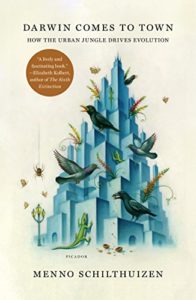 I just finished this book, Darwin Comes to Town by Menno Shilthuizen, about adaptation and evolution in urban environments, which seemed somewhat hopeful. It’s a discussion about how quickly certain species change to thrive in cities. Stories include the hawksbeard dandelion, which evolved to produce heavier seeds so their little parachutes would keep them in the island of green instead of floating off onto asphalt and how crows learn to throw heavy-shelled walnuts into intersections, wait for cars to run over them and then when the light changes, run out to grab the walnut meat after the cars crush the shells.
I just finished this book, Darwin Comes to Town by Menno Shilthuizen, about adaptation and evolution in urban environments, which seemed somewhat hopeful. It’s a discussion about how quickly certain species change to thrive in cities. Stories include the hawksbeard dandelion, which evolved to produce heavier seeds so their little parachutes would keep them in the island of green instead of floating off onto asphalt and how crows learn to throw heavy-shelled walnuts into intersections, wait for cars to run over them and then when the light changes, run out to grab the walnut meat after the cars crush the shells.
But most encouraging was his chapter on the way cites are cooperating globally to understand and improve urban environments. He notes that cities all over the word have similar soil compositions, microbes, insect, bird, and plant life. So “cities as far apart as 2,500 miles share about half their birds, while the avifaunas of natural areas that distant are almost completely different.” The author states that “cities worldwide are beginning to exchange information and undertake concerted action.”
Given the pace at which the natural world is disappearing, at least it’s heartening to know that there are many groups working on innovative ways to make urban spaces more habitable for plants and animals, including humans. My only quibble with the book is the often anthropomorphic language of the anecdotes. Still, worth a read.